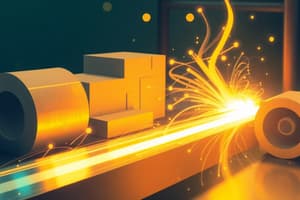Podcast
Questions and Answers
If the original tension specimen results are close to the specified requirements, what is permitted?
If the original tension specimen results are close to the specified requirements, what is permitted?
- Disregarding the specified requirements entirely
- Performing a retest on specimens from a different lot
- Accepting the original results without further testing
- A retest on two random specimens from the same lot (correct)
If a bend test fails for reasons other than mechanical issues or specimen flaws, what action should be taken?
If a bend test fails for reasons other than mechanical issues or specimen flaws, what action should be taken?
- Retest on two random specimens from the same lot at a temperature not less than 60°F (16°C) (correct)
- Retest on two random specimens from the same lot at room temperature
- Conduct the retest on specimens from a different lot
- Discard the entire lot without retesting
If a weight (mass) test fails for reasons other than specimen flaws, what is the appropriate action?
If a weight (mass) test fails for reasons other than specimen flaws, what is the appropriate action?
- Discard the entire lot without retesting
- Repeat the weight test on the same specimen
- Retest on specimens from a different lot
- Retest on two random specimens from the same lot (correct)
Under what condition(s) is a tension test considered invalid?
Under what condition(s) is a tension test considered invalid?
What is the purpose of retesting on random specimens from the same lot?
What is the purpose of retesting on random specimens from the same lot?
How many retest specimens are required if the original test fails for a valid reason?
How many retest specimens are required if the original test fails for a valid reason?
Flashcards are hidden until you start studying





